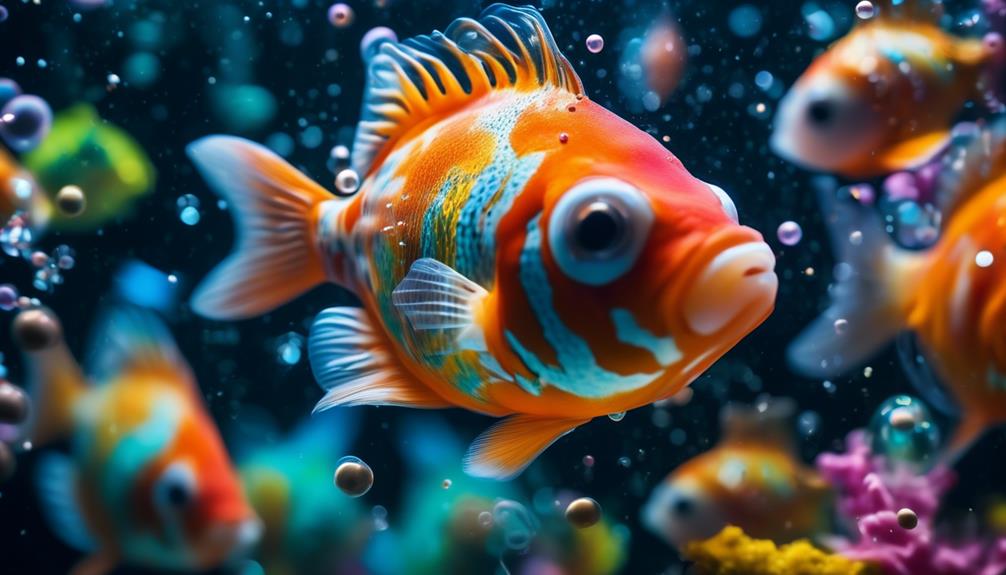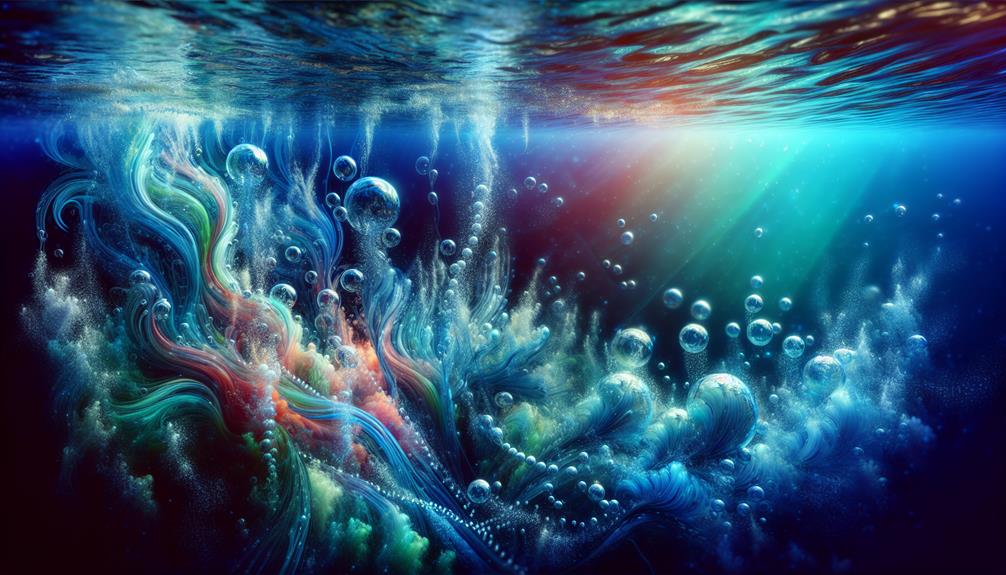Welcome to our investigation into the enigmatic world of aquarium bubbles and foaming. As responsible caretakers of aquatic ecosystems, we strive to provide the best possible environment for our fishy companions. Yet, despite our efforts, these mysterious bubbles seem to emerge, leaving us with a sense of curiosity and concern.
What could be causing these captivating phenomena? Are they harmless or indicative of a more significant problem lurking beneath the surface? In this exploration, we will uncover the various factors that contribute to the formation of bubbles and foaming in your aquarium, offering insights into the hidden secrets of your underwater realm.
Prepare to be captivated as we embark on this journey of discovery.
Key Takeaways
- Normal bubbles from an air pump or CO2 injection in planted tanks are transparent and dissolve quickly upon reaching the water surface.
- Micro bubbles appearing after a water change can indicate the release of dissolved gases, with a large number of bubbles indicating a significant water change.
- Bubbles caused by fish medications or chemicals may have different characteristics, with clear bubbles indicating medication and oily, iridescent bubbles potentially caused by soap or cleaning products.
- An oil slick on the water surface can be caused by a translucent biofilm, often formed by fish foods, oils from hands, or organic compounds. Proper surface agitation and oxygenation can help dissipate the oil slick.
Normal Bubbles From Air Pump
Normal bubbles from an air pump are formed by various equipment such as air stones, sponge filters, bubblers, or decorations that introduce air into the aquarium, resulting in transparent bubbles that quickly dissolve upon reaching the water surface. These bubbles are a natural byproduct of the aeration process and play a crucial role in maintaining oxygen levels in the aquarium.
However, excessive air pump bubbles can be undesirable as they can disrupt the aesthetic appeal of the tank and cause unnecessary stress to the fish. To prevent excess air pump bubbles, it is important to ensure that the equipment used is appropriate for the size of the aquarium and the needs of the fish.
Regular maintenance and cleaning of air stones, sponge filters, and bubblers can also help prevent the buildup of debris and excessive bubbles. Additionally, adjusting the air flow rate and using a check valve can help regulate the amount of air introduced into the aquarium, reducing the occurrence of excess bubbles.
Micro Bubbles After Water Changes
Micro bubbles may appear in the aquarium after water changes due to the release of dissolved gases. While some bubbles are normal and will dissipate on their own, excessive micro bubbles can be a cause for concern. Here are some possible causes and ways to prevent and reduce micro bubbles after water changes:
| Causes of Excessive Micro Bubbles After Water Changes | How to Prevent and Reduce Micro Bubbles After Water Changes |
|---|---|
| Rapid water changes causing a sudden release of gases | Perform water changes slowly and gradually |
| Use of water conditioners or dechlorinators | Allow the water to sit for a few minutes before adding it to the aquarium |
| Aggressive siphoning, stirring, or shaking of water | Handle the water with care and avoid vigorous movements |
| Dirty or clogged filter media | Clean or replace the filter media as needed |
| Presence of fine substrate particles in the water | Use a fine mesh net or filter to remove any debris |
Fish Medications or Chemicals

Excessive foaming in the aquarium can also be caused by the use of fish medications or chemicals. These substances can alter the viscosity of the water and contribute to the formation of bubbles.
When using fish medications, it is important to consider their effects on the aquarium water chemistry. Some medications may change the pH or other water parameters, which can affect the overall health of the fish. Additionally, the presence of bubbles caused by medication may take longer to disperse compared to normal air bubbles.
When cleaning and disinfecting aquarium items, it is crucial to avoid causing excessive foaming. Rinsing items with water for cleaning and using a diluted bleach solution for disinfection can help prevent the formation of excessive bubbles.
Ensuring that items are completely air-dry before returning them to the aquarium is also essential in maintaining a healthy aquatic environment.
Oil Slick on Water Surface
The presence of an oil slick on the water surface in an aquarium is typically caused by a translucent biofilm that forms and traps bubbles. This biofilm is formed from various sources, including fish foods, oils from hands, and organic compounds present in the aquarium. The lack of surface agitation and proper gas exchange allows the oil slick to become visible. To prevent the formation of oil slicks, it is essential to increase surface agitation and oxygenation. This can be achieved by using a sponge filter or aiming the filter's output at the water surface. Additionally, removing overgrown floating plants that hinder surface agitation can help dissipate the oil. To remove existing oil slicks, manual removal using a clean cloth or paper towel is recommended. It is important to avoid using any chemical solvents or detergents as they can be harmful to aquatic life.
| Causes of oil slick formation | Prevention and removal of oil slicks |
|---|---|
| Translucent biofilm | Increase surface agitation |
| Fish foods and oils | Use a sponge filter |
| Lack of surface agitation | Remove overgrown floating plants |
Excess Ammonia

Excess ammonia in an aquarium can lead to detrimental effects on fish health and water quality. Understanding the causes and effects of excess ammonia is crucial for maintaining a healthy aquatic environment. Here are four key points to consider:
- Causes of excess ammonia:
- Overstocking the aquarium with too many fish
- Overfeeding, leading to uneaten food and increased waste production
- Debris falling into outdoor ponds, such as leaves or dead plants
- Insufficient biological filtration, causing a buildup of ammonia
- Effects of excess ammonia on fish health:
- Ammonia is toxic to fish, damaging their gills and impairing their ability to breathe
- It can lead to stress, weakened immune systems, and increased susceptibility to diseases
- Fish may exhibit symptoms such as gasping for air, loss of appetite, and lethargy
- In severe cases, high levels of ammonia can be fatal to fish
To maintain a healthy aquarium, regular monitoring of ammonia levels and taking appropriate measures to reduce excess ammonia is essential.
Frequently Asked Questions
How Do I Prevent Excessive Foaming Caused by Fish Medications or Chemicals?
To prevent excessive foaming caused by fish medications or chemicals, ensure thorough rinsing and air-drying of items before returning them to the aquarium. Avoid using soap or cleaning products that may produce oily, iridescent bubbles. Implement proper surface agitation and gas exchange to dissipate oil slicks.
Can a Lack of Surface Agitation and Proper Gas Exchange Lead to the Formation of an Oil Slick on the Water Surface?
A lack of surface agitation and proper gas exchange in aquariums can lead to the formation of an oil slick on the water surface. This can have a negative impact on aquatic life, as it hinders oxygenation and can trap bubbles, affecting the overall health of the ecosystem.
Is There a Way to Determine if the Foaming in My Aquarium Is Caused by Excess Ammonia or Other Harmful Chemicals?
To determine if foaming in your aquarium is caused by excess ammonia or other harmful chemicals, use ammonia and multi-test strips. Unusual foaming in the absence of medication may indicate excess ammonia or other harmful substances.
Why Do Male Betta Fish Create Bubble Nests and What Purpose Do They Serve?
Male betta fish create bubble nests as part of their natural breeding behavior. They use their saliva to create bubbles and pile them together in a calm area. The purpose of the bubble nest is for the male to gather and protect the eggs until they hatch. Foaming prevention can be achieved by minimizing surface agitation and providing a calm area for the nest to be built.
What Is the Significance of Plants Pearling in an Aquarium and How Does It Indicate High Oxygen Levels?
The significance of plants pearling in an aquarium lies in its indication of high oxygen levels. This process occurs when plants release tiny bubbles as a result of photosynthesis, contributing to a well-oxygenated environment that benefits aquatic life.
Conclusion
In conclusion, understanding the causes of bubbles and foaming in your aquarium is crucial for maintaining a healthy aquatic environment.
By identifying normal air pump bubbles, micro bubbles after water changes, and potential issues such as fish medications or excess ammonia, you can address any concerns and ensure the well-being of your aquatic inhabitants.
Additionally, the behaviors exhibited by certain fish species, such as bubble nest creation and pearling plants, add to the fascination and complexity of aquarium ecosystems.

